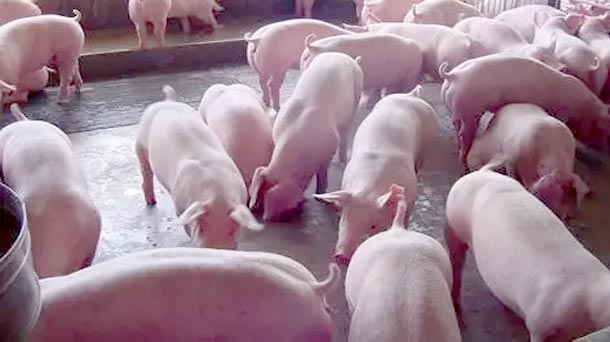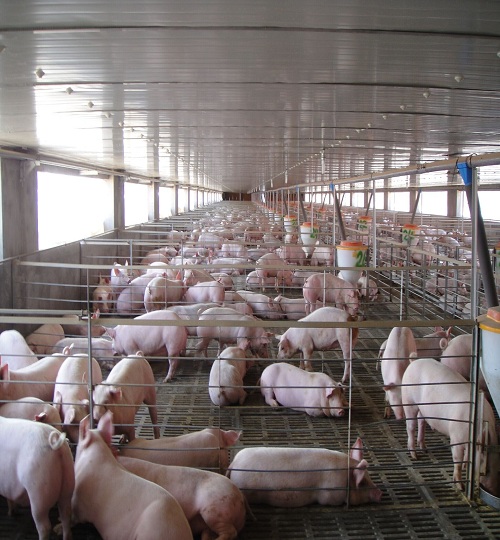The raising of fattening pigs in modern pig farms is an important technology, so how to manage fattening pigs is to create profits for pig farms. “6 key points of raising finishing pigs” is to explain how to fatten.

There are great differences in feed conversion rate, growth and development speed, weight gain speed, meat production performance and meat quality of different breeds of raising finishing pigs.
Therefore, pig farms need to select suitable varieties according to feeding purposes before fattening.
At present, there is a large demand for lean pig breeds in the market.
Therefore, all farms generally choose fattening lean pig breeds, and most of the commonly used varieties are binary hybrid offspring,
such as the hybrid offspring of lean boars such as Dabai, Changbai and Duroc with some raising finishing pigs.
1.2 individual selection
In terms of individual selection, it is required to select pigs with strong physique, good mental state, glossy fur, bright eyes,
long body, straight waist and back, and broad chest.
Such pigs usually have fast growth and development, good weight gain effect, high feed conversion rate,
low morbidity and mortality during the fattening period.
Feed is the basis of fattening pigs, and the feed cost accounts for a large proportion of the pig breeding cost.
Therefore, in order to promote the growth and weight gain of fattening pigs and save feed cost, it is necessary to provide diets scientifically and reasonably.
First of all, we should scientifically design the feed formula, and design the diet according to the local feed resources and the nutritional needs of raising finishing pigs at different stages.
In the selection of feed raw materials, we should pay attention to the quality of raw materials, choose high-quality feed raw materials, and do not covet cheap and choose poor ones
For high-quality feed materials, the selected feed materials should be free from mildew and moisture content should not be too high.
Reasonably prepare feed, improve the palatability of feed, improve the digestion and absorption rate of feed, and eliminate harmful factors.
All nutrients in the feed shall be sufficient, and the collocation of all nutrients shall be reasonable.
The supply of minerals, trace elements and vitamins cannot be ignored.
The feed form of is generally semi dry and semi wet, so that the feed can improve the feed intake of pigs and provide them with sufficient drinking water.
3.1 provide suitable breeding environment
A suitable breeding environment can promote the growth and weight gain of raising finishing pigs, improve the feed conversion rate, and make them give full play to their production performance,
And it can also reduce the breeding cost, so as to achieve the best economic benefits of raising finishing pigs.
Therefore, it is necessary to strengthen daily management, provide a comfortable growing environment for raising finishing pigs,
do a good job in the hygiene and cleaning of pig houses, clean the pens every day,
and regularly disinfect the pig houses and appliances comprehensively, strengthen ventilation and timely discharge
Ammonia, hydrogen sulfide and other harmful gases are discharged from the pig house to keep the air in the pig house fresh. In addition,
the environmental temperature of the pigsty should be kept appropriate
In order to prevent heatstroke in summer and cold in winter, the most suitable temperature for growing finishing pigs is usually 18 ~ 22 ℃.
3.2 control the feeding density of pigs
At present, most pig farms adopt the intensive and intensive feeding management mode,
and the feeding density is usually large, which is unfavorable to the production performance and health of the pig herd.
3.3 reasonable feeding
In daily management, attention should be paid to feeding regularly and quantitatively, and a small amount of frequent feeding,
so that finishing pigs can develop a good feeding habit
Habit can make feed fully digested, improve feed conversion rate, avoid feed waste and save feed cost.
Different fattening methods have different advantages, and the quality of the fattened commercial pigs is also different.
It is necessary to choose the appropriate fattening method according to the market demand and the breeding conditions of the farm.
High quality fattening methods mainly include “fine at both ends and coarse in the middle”
This method, also known as “hanging rack” fattening method, is to feed high-precision diet at the stage of piglets,
and at the same time, mix a small amount of green roughage.
The characteristic of choosing this fattening method is that it can make full use of a large amount of green roughage and save feed costs.
Feed rich in protein and minerals is provided by the feeding method of food intake, but it needs to be restricted in the later stage,
so as to improve the lean meat rate and meat quality.
Pigs in fattening stage have stronger resistance and lower incidence rate than pigs in other stages, but disease prevention still needs to be done well. Head
It is best to choose the feeding management mode of “all in and all out” first, so as to avoid diseases among pigs of different ages and batches
Infectious disease can also be effectively avoided by thoroughly disinfecting pens and tools after being released.
Do a good job in the sanitation and cleaning of the enclosure, clean up the feces in time, and comprehensively disinfect the pigs,
pig houses and utensils regularly, which can kill pathogenic microorganisms and reduce the occurrence of diseases.
The finishing pigs also need to be deworming regularly, and deworming and prevention should be carried out three times at the age of 45 days, 90 days and 135 days.
Insecticides should be broad-spectrum, high-efficiency and no side effects to eliminate parasites inside and outside the body.
After growing finishing pigs are raised to a certain extent, the growth and weight gain speed will slow down, and continued feeding will not only cause feed waste, but also
The carcass quality will be reduced. If it is released too early, the slaughter rate is low and the meat quality is poor.
Therefore, it is necessary to comprehensively consider the daily gain, feed meat ratio, lean meat rate, slaughter rate, breeding cost, market price, and variety characteristics of growing and finishing pigs, so as to timely release them.
General hybrid commercial meat pigs are best when their body weight is 90-100kg.

Mus Agro an excellent Pig farm Fattening Pen equipment manufacturer.
If you plan to build a new piggery farm, you can contact Mus Agro by [email protected], we can offer a free designing for your piggery farming project!